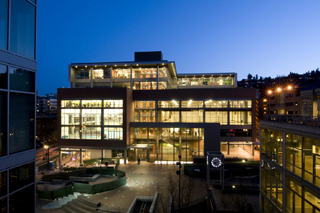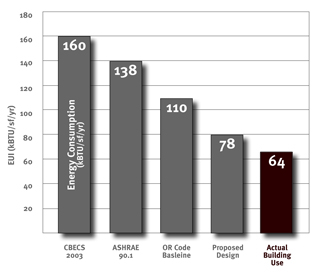|
Subscribe / Renew |
|
|
Contact Us |
|
| ► Subscribe to our Free Weekly Newsletter | |
| home | Welcome, sign in or click here to subscribe. | login |
Environment
| |
 |
February 28, 2013
A crucial step that green building teams often skip
Interface Engineering

Michaels
|
One of the best ways to improve building design is to find out what worked the way we expected, what did not and, most importantly, why.
When it comes to high-performance building design, one of the most important aspects of the approach is often left out in the traditional model and fee: the post-occupancy evaluation.
The standard process has four stages: the concept or pre-design phase, followed by detailed design and construction documents, construction administration and, finally, commissioning. Once commissioning is complete, the owner, design team and contractors shake hands and celebrate the success of the project.
The project may have met its sustainable goals on paper, achieved LEED certification, been listed with Green Globes or obtained a number of other energy performance or occupant health targets. But the real test of success comes a year or two later when we review building operations and compare its performance with design expectations.
This post-occupancy evaluation is the fifth element of high-performance building delivery. It is essential to help us understand what investments in design, construction and operations bring owners and users the best advantages for the dollars spent.
Making buildings work
High-performance building design is a process of continual improvement, innovation and the application of new technology. There are five key steps to making high-performing buildings work:
1. Discuss performance targets and provide early data so that energy efficiency is part of the team’s conceptual design phase. Major impact items include:
• Owner and architect expertise on how the building will be used
• Energy calculators to compare building construction and system options for the area of installation and use type
• Relative order of magnitude cost differences among the system options under consideration
• Collaborating to select the best two or three options to pursue
2. Conduct a detailed analysis of the likely building performance:
• Predict energy savings and their approximate capital and operating costs for selected options
• Consider options for low energy, net-zero energy and net-zero water designs
• Tools include detailed energy analysis software, daylighting analysis, renewal energy analysis, innovation of systems configurations, energy modeling expert, and collaboration
3. Incorporate cost-effective ways to meter or track energy consumption, and isolate energy end-use categories into the design:
• Examine design options to reduce metering points. Use smart meters than can meter more than one item. Examine devices with integral metering to leverage what we can monitor by adding a network card. Consider using HVAC building-management systems and digital lighting-control systems to calculate consumption and utilization to save on metering costs.
• Include easily accessible feedback to the end users in the design, including kiosks, smartphone apps, text messaging opt-in options, desktop apps, digital gauges vs. numbers, and energy-efficiency reward or status programs. Many of these options can be provided using equipment the users need to purchase for another use and save project cost.
4. Commission the project during construction administration:
• Great design ideas can fail if it is not clear how to use them, why they are there, or if they are not set up correctly from the start.
• Cutting corners during construction can result in significant energy-performance impacts.
• Create clear and simple documentation so future users of the space continue receiving the benefits of the design. Sometimes laminated floor plans or diagrams with simple instructions end up more valuable to users than DVDs, flash drives and 20 notebooks full of data.
5. Lay groundwork during the design phase for a successful post-occupancy evaluation:
• Discuss with owners the benefits of post-occupancy evaluations as a service to save operations and maintenance costs, and improve employee satisfaction. Historically, user likes and dislikes about a facility are often only reviewed for an owner’s next project. Comparing energy consumption to design goals after a year of operations provides refresher training to staff and can identify operational or system problems that may have a direct impact on the bottom-line operating costs.
• Maintain the metering or points where meters can be installed in the design so the data needed during a post-occupancy evaluation can be easily obtained.
• Categorize systems to determine which ones are overperforming or underperforming versus the original design goals and the energy model. Identify the reason. If possible, recommend modifications for the underperforming systems.
Items that impact performance include solar gain or heat loss through windows, roofs, walls and doors; building leakage due to failed or improperly sealed components; zones within HVAC systems not working due to bad sensors; a closed valve, an open window or door, or a switch someone thought should be in a different position. Listen for the “that never worked” or “we decided to do it this way” comments.
• If the building use changed or has different hours of operation compared with the original design, suggest how systems can better support the current needs and examine how effectively systems designed for different parameters can adapt to a revised operating condition.
• Learn from what we find. Provide feedback to energy consultants. Be willing to agree that some design ideas do not perform as well as we thought they would, and find out why because they may still be a great idea if done differently.
Consider keeping systems simple to operate and maintain by reducing the number of complex items or by making the design somewhat modular so it is repeated throughout the facility or campus. Update the high-level information for use in the next conceptual design.
Results are in
Interface Engineering has had the opportunity to reexamine facilities and perform post-occupancy energy usage evaluations in comparison to design goals for a number of projects. Results by facility type can vary based on a number of factors, but each has provided valuable information to help update performance models and better understand client operational needs over time.
The AEC community must continue to advance the built environment — designing high-performance buildings save energy, water, materials and our environment. Collaboration and communication among architects, owners, developers and other team members is an important part of making high-performance buildings a success.
The fifth element of design — post-occupancy evaluation — is the next critical step. Together, we can move our industry and projects to new levels of performance.
Philip Michaels is a principal at Interface Engineering.
Other Stories:
- Don’t let green-minded clients leave you behind
- New transfer station lifts Makahs out of the dumps
- Engineering school’s new home reflects its values
- Falling costs could mean a bright future for solar panels
- Is LEED’s future with federal projects under threat?
- Thermal ‘ravioli’ keeps building temps in check
- Bullitt neighbor seeks a green distinction of its own
- How contractors can make the supply chain greener
- What to look for in a green building




